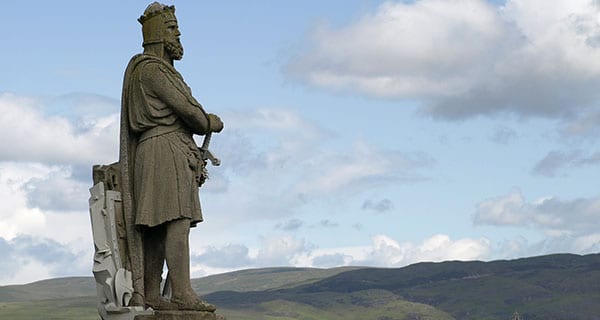 Reading about the forthcoming Outlaw King movie reminded me of a childhood story. The subject of both the movie and the story is Robert the Bruce (1274-1329), the famous Scottish king who routed the English at Bannockburn and paved the way for Scotland’s independence.
Reading about the forthcoming Outlaw King movie reminded me of a childhood story. The subject of both the movie and the story is Robert the Bruce (1274-1329), the famous Scottish king who routed the English at Bannockburn and paved the way for Scotland’s independence.
The childhood story had a moral about the value of persistence and patience.
While on the run from English and Scottish enemies in the early 1300s, Bruce took refuge in a cave on Rathlin Island off Ireland’s northeast coast. There, he was transfixed by a determined spider’s efforts to spin a web. The spider failed repeatedly but ultimately prevailed, imparting the lesson that “If at first you don’t succeed, try and try again.” So duly instructed, Bruce returned to Scotland and ultimately vanquished his enemies.
True or false, it’s an inspirational tale.
And as national narratives go, the rendering of Bruce as the father of Scottish independence is reasonable. The events in question happened and recalibrated the relationship between Scotland and England. Bruce, therefore, is an early nationalist hero.
But there’s another, also reasonable, way of looking at it.
If we put in abeyance modern concepts of national identity and focus on 14th century perspectives, the developments leading to Bruce’s momentous victory have a different dimension. To quote historian Hugh Kearney, they can be seen as “a struggle for power within the Norman ascendancy.”
None of the major protagonists were indigenously Scottish or English. They’d all come to the British Isles as the new aristocracy in the wake of William the Conqueror’s successful 1066 invasion. Their paternal lines were Norman-French.
Bruce was actually a de Brus. His paternal ancestor first established a base in England before the family acquired lands in Scotland during the early 12th century. These acquisitions were contemporaneous with those of other iconic Scottish families like Fraser, Haig and Stuart – as Kearney wryly observes, “many of them today complete with tartan and kilt.”
Bruce’s rival for the Scottish crown was John Comyn. The Comyn family had a similar backstory, arriving in Scotland in the 12th century. They, too, were Norman-French.
And the English kings Bruce fought against – Edward I and Edward II – were Plantagenets, direct descendants of Henri d’Anjou, who took the English throne in 1154. We know him better as Henry II.
Adding extra spice to this inter-ascendancy power struggle, Edward I was attempting to change the rules of the feudal game. In Kearney’s words, Edward was seeking to shift “his position from that of feudal overlord to one of imperial dominance.”
In the Norman version of feudalism, the overlord/vassal relationship implied reciprocity and autonomy. The vassal would submit to the overlord and promise to provide loyalty and service, often by way of military assistance when required. In return, the overlord would promise to protect the vassal and would refrain from unduly interfering with how the vassal conducted his affairs.
Strange as it may sound, this kind of relationship could apply between kings. Indeed, various Scottish kings were vassals of their English counterparts. But geographical realities being what they were, the relationship was usually nominal. The Scottish king would pay homage and then go about his business as usual.
Edward, though, decided to change the dynamic. He was going to interfere, thereby diluting local autonomy.
So with the Scottish throne vacant and Edward working towards effective annexation, Bruce proceeded in the time-honoured fashion of medieval power aspirants. He killed his rival, John Comyn, and had himself crowned king of the Scots at the traditional coronation site of Scone Palace in March 1306.
Initially, things didn’t go well.
Not all of the Scottish nobles accepted Bruce and he was badly defeated by an Anglo-Scottish army at the Battle of Methven. He went on the run until he had his fateful rendezvous with the spider on Rathlin Island. Or so the legend goes.
Then, shortly after his return to Scotland in 1307, Bruce caught a major break. Edward I died and was replaced by his ineffectual son, Edward II.
Nicknamed Longshanks because of his unusual height, Edward I was a formidable character and a ferociously effective warrior. Edward II was neither.
Without taking anything away from Bruce’s accomplishments culminating in the famous 1314 victory at Bannockburn, one wonders whether events would have played out the same way if the senior Edward had lived.
Then again, history’s like that.
Troy Media columnist Pat Murphy casts a history buff’s eye at the goings-on in our world. Never cynical – well, perhaps just a little bit.
The views, opinions and positions expressed by columnists and contributors are the author’s alone. They do not inherently or expressly reflect the views, opinions and/or positions of our publication.

